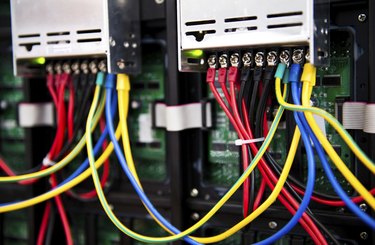
Modern computers often have multiple physical and software-based network adapters. People and machines alike can use system-assigned network interface index numbers to tell network elements apart. You can find all of your computer's network interface index numbers using the "route" command in the command prompt. Network interface index numbers differ from Internet Protocol addresses in that they are used within a single device to direct traffic, while IP addresses regulate inter-device communication.
About Network Interface Index Numbers
Video of the Day
According to Cisco, an interface index value is a unique identifying number for a physical or logical network device. Starting at the number one, the computer assigns an index number to each device to designate network traffic paths. Typical computer uses on small networks don't need to worry about adjusting network traffic with the interface index numbers because the network hardware automatically configures traffic paths. However, larger scale networks that are concerned about performance speed can use the interface index numbers to control network data paths. If the computer initializes the network devices through a reboot it may reassign index numbers; computers need to keep interface index numbers persistent when using specified network paths.
Video of the Day
List Device Network Interface Index Numbers
The command prompt has all the tools you need to identify interface index numbers and adjust network paths. You can launch a command prompt by pressing "Windows Key-R," typing "cmd" and pressing "Enter." Select the command prompt window, type the command "route print" and press "Enter" to display the "Interface List" and system routing tables. The interface index numbers appear under the Interface List in the left column and correspond to the physical or logical device listed in the right column. Alternatively, you can enter "route print 256.*" to display the Interface List with blank routing tables. The interface index has an integer value; however, older operating systems may display the value in hexadecimal instead of base-10 with a "0x" before the index number.
Get More Device Information
While the Interface List ties each index number to a device, the device names may not be particularly descriptive as to what they do. You can find more information on each of the devices by entering the command "ipconfig /all" into the command prompt. The ipconfig command does not display the index number; rather, it is used to display and adjust TCP/IP network values. The ipconfig command breaks out each device by the same name used in the Interface List and provides more information, including a device description, device activity status and the path the device is using to connect to the network.
Interface Index Numbers Are for Specificity
Network traffic will take any path available to get from the origin system to the destination system. The interface numbers are useful for specifying which path traffic takes between systems. For example, the command "route -p add 1.2.3.4 mask 255.255.0.0 5.6.7.8 if 0x1" instructs all traffic leaving through index device 1 going to the device at example IP address "1.2.3.4" to go to the device at "5.6.7.8" next on the way to the destination.
- Cisco IP Application Services: Interface Index (ifIndex) Persistence
- Microsoft TechNet: Route
- Cisco.com Worldwide Home Products & Services Support How to Buy Training & Events Partners Search Worldwide [change]Log In AccountRegisterMy CiscoClick to open Cisco Unified Intelligent Contact Management Enterprise: How to Use the Route Command
- Computer Hope: Microsoft DOS Route Command
- Microsoft TechNet: Ipconfig
- Computer Hope: Microsoft DOS Ipconfig Command
- Techopedia Definition: Next Hop